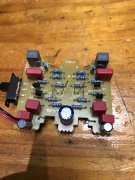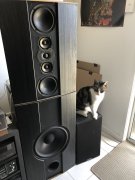Got it, yes. Did about 10 hours work on it. Had to bypass a few tracks due to losing the solder pad. There were challenges due to capacitor size, managed to squeeze them in. The nichicon muse caps would not fit into the connector holes, the legs on them were too thick. I resorted to putting in separate legs and mounting the caps horizontally, not ideal and looks messy but it works, and thats all that matters.
Those BC237B replacement transistors have the wrong pinout, fuck! Had to put the C1740’s back in.
First test run the left channel was dead, tested Q1 which had an abnormally high value, took it out and tested out of circuit, no issues. Found C5 and C6 almost shorting, trimmed the legs to fix. Put Q1 back in, tested ok. tested for continuity and shorts all over the board. Now Im listening and it sounds sweet. Will record that same track used last time for comparison and share soon. No pics of soldering side of board, its a war zone

Rca input/output replaced with gold plated type.
Cap/Resistor make and type used:
Koa Speer Resistors mostly 1%
Wima MKP, FKP 2.5%
Cornell Dubilier CDE Grey Film (For the 50v/1uf 5% Cap, couldnt find Wimas in this value)
Elna Silmic 2’s (Electrolytic)
Nichicon UES and UKZ (Electrolytic)
Stocked up on 50v/1uf Nichicon Muse BP green caps, just for shits and giggles, these come in handy, forever running out of them.
By the way, used sil pads are handy to protect the board from the jaw clamps.



















